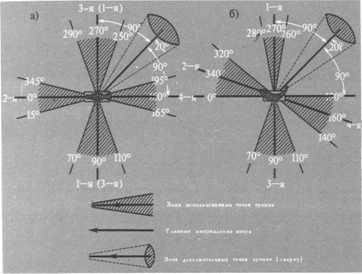
The most important feature of modern furniture is its compliance with ergonomic requirements. Ergonomics is a field of science that deals with the problems of optimizing human interaction with equipment and the environment in the process of life activity. It arose as a result of actual problems of progressive industrialization, it develops in parallel with industrial design and is based on the wide use of the methods and results of such sciences as the physiology of labor, industrial hygiene, anthropology, engineering psychology.

Fig. 1. Zones of comfortable conditions
Anthropometric, hygienic and psychological ergonomic requirements are applicable to the design of furniture, as one of the most essential elements of the equipment of an artificially created internal environment ensuring optimal working and rest conditions.
The development of the interior and its equipment is based on a comprehensive study of the conditions affecting the physiological state of a person (Fig. 1). Environmental exposure is taken into account through indicators such as heart rate, respiratory rate and blood pressure under comfortable conditions. By developing the internal environment and its equipment, they strive to ensure that a person can work effectively for short and long periods of time.
Of particular importance among a number of other factors are anthropometric data characterizing the size of the human body. The correct choice in accordance with the anthropometric data of the dimensions of the planning elements of the premises, equipment and furniture connects them into a single system and contributes to the creation of a comfortable internal environment, convenient for conducting one or another functional and technological process. Consideration of some examples of the choice of sizes of furniture products for residential and public buildings allows you to more fully understand this feature of the design of modern furniture.
Most consistently, the principle of matching the size of comfortable zones with anthropometric data is observed when designing household furniture for residential and utility rooms (Fig. 2). The size and proportions of the human body have a particular impact on the size of some furniture groups. This primarily applies to children's furniture products. The size and configuration of children's furniture affects the physical development of the child. Improperly selected dimensions of individual products of children's furniture can lead to slouching, myopia, etc. Therefore, an important condition for the design of children's furniture is the mandatory compliance with its age and growth characteristics and the physical development of children and adolescents. Correspondence of children's furniture to the growth of a child ensures the correct position of his body during occupations and games, and also contributes to the education of independence and the acquisition of skills of using things.
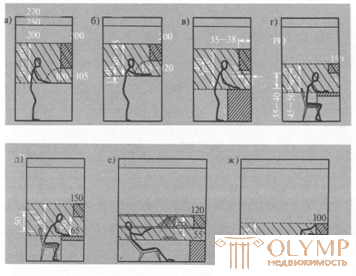
Fig. 2. The main anthropometric data for the definition of household furniture: a, b - the level of the secretory board; in - kitchen furniture; g d - desktops; e - a place to rest; Well - a place to sleep.
Accounting for age-growth features suggests various options for transforming the product by size or purpose (children's beds, the length of which can be increased as the child grows, work tables with varying heights, chairs for younger children, which can serve as a table for games, etc.) d.)
The dimensions and proportions of a person especially strongly influence the choice of sizes of chairs and armchairs, the method for determining which most fully reflects the approach to solving modern furniture. Significant in this regard, the work of the Swedish doctor Akerblom, who, guided by anthropometric data, found rational parameters of chairs and chairs, providing maximum convenience.
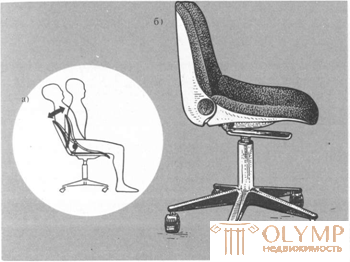
Fig. 3. The influence of the size and proportions of a person on the choice of sizes and design of chairs: a - analysis of a person’s posture; b - working chair
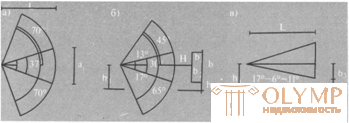
Fig. 4. Scheme of the visual field: a - horizontal angles of visibility; 6 - vertical angles of visibility; in - the minimum raising of the work of art from the floor, based on the conditions of clear visibility; and - the overall height of the image; h is the height of the image; hi is the observation height; b - image height; bi is the height of the upper half of the image;
Each group of furniture products has specific features arising from their functional purpose, which determines the choice of basic overall parameters.
In administrative, clerical and other workplaces, the design of the workplace, including a desk and chair, is of particular importance (Fig. 3). The conditions that are necessary for a working person in the workplace should be consistent with the technical and organizational requirements. Sometimes jobs at which technical tasks are solved cause extra physical exertion.
The parameters of theatrical chairs, which in different countries vary in size depending on the average person's height, also indicate the influence of growth and the proportion of a person on the choice of furniture sizes. Considering the equipment and furniture of stores, department stores, restaurants, cafes, etc., one can make sure that the dimensions and proportions of a person significantly influence the choice of dimensions and this equipment. For normalization, standards are being developed for the functional dimensions of household furniture (GOST 13025.1 —71 — GOST 13025.13 - 71), trade (GOST 18.310.2 - 73 - GOST 183104 - 73), for catering enterprises (GOST 17524.1 - 72, GOST 175244.6 - 72 ), children's furniture for preschool (GOST 19301.1 - 73 - GOST 19301.3 - 73) and others.
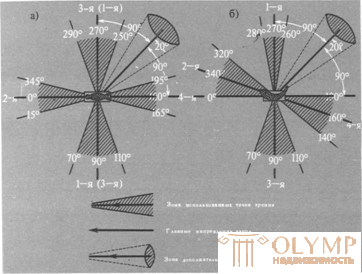
Fig. 5. Schematic representation of the use of points of view: a - volumetric model; b - relief model
When creating the interior and designing furniture, especially when choosing means of artistic expressiveness, it is important not only to substantiate the main geometric parameters with anthropometric data, but also to take into account the human perception of the environment (Fig. 4). The perception of the form has two aspects (the perception of the three-dimensional form and the perception of the relief), which differ in tasks and capabilities.
It has been experimentally proven that the volumetric form is perceived by changing a few points of view (Fig. 5), which are not strictly defined. Their number and distribution, as well as the size of their zones, depend on the nature of the perceived form. For practical activities, the choice of the main direction of the point of view is very important, since it corresponds to those aspects of the thing in which its objective meaning is most clearly expressed, that is, the characteristic parts of the thing and signs are best seen. With regard to furniture, this provision can be illustrated as follows. Depending on the nature of perception, furniture products can be divided into relief forms (cabinets and shelves) and three-dimensional forms (tables, chairs, armchairs) (Fig. 6). So. when looking at the table, the shape of its lid is first perceived and remembered, and then the supporting frame. When looking at a chair or chair, the shape of the seats and backs is primarily perceived. This position is important in practical terms, as it allows the designer to focus his efforts in a certain direction. For example, to create a variety of tables, it can vary the memorable shape of the table cover.
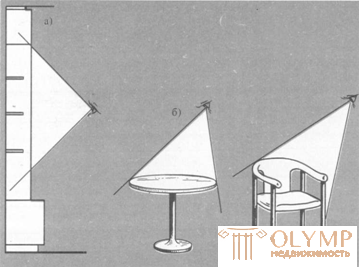
Fig. 6. The main forms of furniture products, depending on perception: a - relief (cabinets and shelving); b - voluminous (tables and chairs)
Along with the main point, additional points of view on zones are important, which are finally determined only in the process of perception itself. Each new additional point of view should provide an answer to the ambiguities that arose before perception. Evaluation of the relief from one point of view is still imperfect, but visual assessments obtained from additional points of view raise the perception of the relief to a new level - full-fledged perception of volume.
When searching for the art form of the product, one of the important aspects of the design is to take into account the main and additional points of view, which follows from the planning features and options for placing the product indoors. Here the conditionality of the decision of a furniture product by the architecture of the building and the room is manifested with particular force.
For the practical activities of the designer, the similarity of visual perception with thought, that is, a generalization, is also important. N. N. Volkov analyzes perception, where generalization is connected with thought, for example, the perception of a number of architectural forms - internal spaces. He writes: “Imagine that we are inside a room of the usual format, and we will try to stretch the length of the room. After some usual form, which is close along the contour of the base to the square, for a long time we will perceive the same quality, the quality of "room", until finally the room is not. stretches so much that we will see: “not a room, but a corridor”. We will begin to narrow the corridor - for a long time there will be a corridor until we see a “gap”. We return to our room and will raise the ceiling. The moment will come when we will see ourselves in the "well".
Let us call the gap of changes in which the form remains the carrier of the same quality, “room”, “corridor”, “slot” - the term zone. Thus, a continuous series of variations of the inner quadrangular space disintegrates into zones for perception. The “room” zone, as attentive analysis shows, breaks up, in turn, into private zones: first - the “strict”, “closed” room, then the “cozy” room, and finally - the “extended” room.
There are other examples where the generalization of a scientific concept conflicts with the generalization of perception. Consider the perception of variation in room size; Let all the rooms be like each other. The perception of a whole range of variations can be represented in the form of three zones; “Room” dimensions will, on the one hand, be converted to “outside” dimensions, and on the other, into “closet” dimensions, which is a transition from one zone to another. The area of change to which this indefinite perception extends, the area of the struggle between two qualities, the area of transition is called the zone of uncertainty. Thus, between any two zones of clear quality there can be a more or less extensive area of uncertainty.
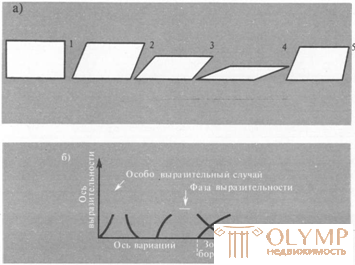
Fig. 7. Illustration to the concept of area: good quality; 6 - schematic a - variations within one zone
Let us now make the same form make a series of variations within one zone of clear quality, for example, the “room-number” zone. Among the variations, firstly, the group of the best representatives of quality stands out, who not only belong to the area of a given quality, but also express this quality, serve as representatives of the forms of this quality. Thus, parallelogram number 3 belongs to the group of expressive representatives. Secondly, in the band, between the zone of uncertainty and a group of expressive forms, there is a gradual increase in the expressiveness of quality, which, however, remains quite clear throughout the entire zone. ”
The structure of a number of zones can be represented graphically in the form of a wave-like curve, in which more or less significant segments of the horizontal axis are inserted between the waves, and the vertices are very high special, “torn off” pieces or points. The axis segments express bands of uncertainty that lie between different qualities. Cut off pieces in the tops of the waves correspond to the most expressive forms.
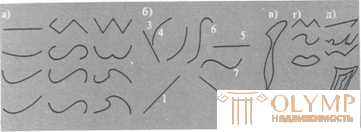
Fig. 8. Psychological influence of lines: a - variants of curved lines; b - emotional expressiveness of lines; c, d, e - figures of varying degrees of dynamism
Taking into account the structure of perception zones allows one to give preference to expressive, contrasting forms, clearly identified proportions and ratios in the product.
Lines have their own characteristics. They can be divided into three emotionally different groups: straight; with a constant radius of curvature - arc; with a variable radius of curvature — parabolas, hyperbolas, spirals. Straight lines and arcs express a uniform calm movement, since in their nature there is a constancy in changing direction. Lines with a variable radius of curvature are dynamic, expressing non-uniform (accelerated or slow) movement. People can understand lines as abstractions and subconsciously connect them in accordance with their ideas. Lines affect the perception of a person as signs of concepts. Phenomena, with which straight lines can be associated, are extremely rare in nature, therefore, they act only to a small extent on people's organs of perception.
The psychological impact of lines on people is different, but there are some general patterns associated with the structure of the eye and psyche, which allowed us to make certain generalizations. Shown in fig. 54 line 1 symbolizes lifting, line 2 - falling, lines 3, 4 - dynamic plastic, line 5 - constancy, lines 6, 7 - activity. It is believed that the figures formed by these lines also have a certain emotional impact. Some express grace (Fig. 54, c), others - stability (Fig. 54, d), third - activity (Fig. 54, e). Vertical lines give the impression of being slim, emphasizing height. Horizontal lines create an impression of calmness, stability. Diagonal lines underline movement.
Intersecting lines also have a certain psychological effect. Two lines intersecting at a right angle cause a feeling of peace and balance. If there is a point next to the line, depending on the distance between the point and the line, there is an impression of either cramping or destruction.
The use of horizontal lines and divisions in modern furniture improves the conditions for the perception of internal space. In identifying the optimal shape of furniture products, it is also necessary to take into account the illusory properties of lines and areas. There are illusions of straight lines and the illusion of distance between the edges of objects.
If you divide a segment into several equal or unequal parts and compare it with an unreleased segment of equal length, the first one will seem somewhat longer. Similarly, equal squares are perceived. The square with vertical divisions seems much wider than the square with horizontal divisions. When assessing by an eye, membranous and non-member areas and segments, the number of divisions matters: perception activity when the number of divisions is n> 4 is higher than when n ^ 10. A harmonic combination of segments is one that is perceived with minimal effort from the visual apparatus and possibly more poosti and natural way. However, this principle can not be put in the basis of the aesthetic value of the image. The monolithic curves are best perceived by the eye, and discontinuous - with a large expenditure of physiological energy, which creates the impression of a certain lack of clarity of forms.
The perception and assessment of the distances between the object or the details largely depend on the form of the compared elements and their dynamic tendency. There is a tendency to estimate the distance not between the edges, but between the centers of objects. If visual centers are shifted, accentuating them with color, tone, geometric figure, the illusion of distance can be changed in the right direction.
The nature of color perception - one of the most powerful means of artistic expression - largely depends on the characteristics of the human eye. Among the features of the human visual apparatus and features of color perception is the field of view, which is conventionally represented as a solid angle equal to 140 ° and includes four parts: accurate vision, the area of which is located in the center of the angle and is approximately 10 °; central field of view, equal to approximately 25 °, which corresponds to the page of the book or notebook; an environment of 60 °; 140 ° peripheral field of view. From the field of precise vision to peripheral vision sharply decreases. Outside the field of exact vision, details are no longer distinguishable, but differences in lightness and color are clearly visible. In the peripheral field, visual acuity drops to 1 °, but differences in lightness and color are perceived quite clearly. The field of view is constantly changing, including areas of the environment. The specificity of visual perception, due to the field of view, is taken into account especially carefully when assessing factors that affect the conditions of visual work.
When solving the interior as a whole and the furniture, the following basic features of color perception are taken into account: the change in the color of objects, the arrangement of light and shadows on them, the disappearance of details as the object is removed (aerial perspective); color change depending on the light source; color change depending on the neighborhood of another color. Observations and numerous studies have revealed the effect of different colors on a person.
The effect of color on the human psyche is due to associations. It is known that red, orange colors are associated with the idea of fire, flame, heat. The blue color is reminiscent of the sky, the sea, the ice and causes a feeling of cold.
Цвет возбуждает и успокаивает в зависимости от длины волн и частоты колебаний. Цвета коротковолнового участка спектра успокаивают, длинноволнового — возбуждают, средневолнового— расцениваются как цвета психофизического равновесия. Красный цвет имеет стимулирующее действие, вызывает сильные реакции и мускульное напряжение, оранжевый цвет вызывает радость, создает чувство теплоты и веселья, но может скоро утомить. Желтый цвет подобно красному и оранжевому имеет стимулирующее действие. Зеленые и голубые цвета успокаивают, способствуют тихому отдыху, сну. Фиолетовый цвет вызывает чувство холода, печали, пассивности, коричневые цвета успокаивают, вызывают депрессию, притупляют эмоции. Холодные цвета (голубые, синие, фиолетовые) всегда воспринимаются как более темные, теплые — как более светлые.
Предметы, окрашенные в теплые и насыщенные цвета, представляются более контрастно, если оба цвета имеют приблизительно одну и ту же же светлоту:
– при сопоставлении двух одинаковых или очень близких по длине волны цветов уменьшается насыщенность цвета;
– слабые, неяркие цвета обесцвечиваются от соседства с яркими и насыщенными того же цвета;
– при сопоставлении двух цветов, не контрастных, но и не близких друг другу по длине волн, различие между ними несколько усиливается; так при сопоставлении желтого и зеленого зеленый будет казаться несколько холоднее (синее), желтый — несколько теплее (оранжевее), чем те же цвета на нейтральном фоне;
– нейтральный серый цвет рядом с сильным ахроматическим цветом всегда приобретает оттенок своего дополнительного цвета: серый узор на красном фоне кажется зеленоватым, на зеленом — красноватым и т. д.
Человек воспринимает цвета в зависимости от их взаиморасположения. Выявлены закономерности сочетания цветов:
– чем темнее фон, тем сильнее контрастное посветление находящихся на нем плоскостей или предметов;
– чем светлее фон, тем сильнее контрастное потемнение находящихся на нем плоскостей или предметов;
– сопоставление двух контрастных или дополнительных цветов ведет к иллюзии их большей яркости и насыщенности (голубой — оранжевый, красный — сине-зеленый и т. д.);
– чем ближе поставлены друг к другу контрастно окрашенные плоскости, тем сильнее эффект контраста; наибольший контраст образуется на границе соприкосновения цветовых полей;
– теплые цвета производят менее контрастное впечатление, чем холодные;
- Contrast is best seen with medium color saturation;
- chromatic contrast is especially noticeable when there is no light tone.
Having considered one of the main features of modern furniture, its compliance with ergonomic requirements, we can conclude that this feature is most closely associated with the aesthetic aspects of the solution of furniture products. This feature primarily affects the choice of functional dimensions, then the choice of the most favorable form for perception, as well as the choice of color.
Что бы оставить комментарий войдите
Комментарии (0)